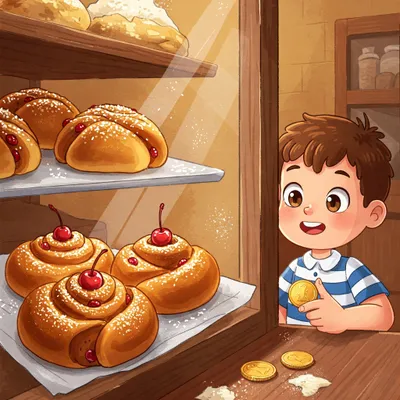Five Currant Buns

Lyrics
Five currant buns in a baker's shop.
Big and round with a cherry on the top,
Along came a boy with a penny one day,
Bought a currant bun and took it away.
Four currant buns in a baker's shop.
Big and round with a cherry on the top,
Along came a boy with a penny one day,
Bought a currant bun and took it away.
Three currant buns in a baker's shop.
Big and round with a cherry on the top,
Along came a boy with a penny one day,
Bought a currant bun and took it away.
Two currant buns in a baker's shop.
Big and round with a cherry on the top,
Along came a boy with a penny one day,
Bought a currant bun and took it away.
One currant bun in a baker's shop.
Big and round with a cherry on the top,
Along came a boy with a penny one day,
Bought the currant bun and took it away.
Big and round with a cherry on the top,
Along came a boy with a penny one day,
Bought a currant bun and took it away.
Four currant buns in a baker's shop.
Big and round with a cherry on the top,
Along came a boy with a penny one day,
Bought a currant bun and took it away.
Three currant buns in a baker's shop.
Big and round with a cherry on the top,
Along came a boy with a penny one day,
Bought a currant bun and took it away.
Two currant buns in a baker's shop.
Big and round with a cherry on the top,
Along came a boy with a penny one day,
Bought a currant bun and took it away.
One currant bun in a baker's shop.
Big and round with a cherry on the top,
Along came a boy with a penny one day,
Bought the currant bun and took it away.
History and Meaning
The counting rhyme "Five Currant Buns" is a traditional English nursery song, likely solidifying its popular form during the 20th century, although its precise origins are undocumented. Like many folk rhymes passed down orally, assigning a specific author or date is impossible, but it emerged as a standard counting rhyme taught to young children.
Its narrative structure is simple and repetitive, describing five buns available in a baker's shop, often characterised as "round and fat with a cherry on the top." Each verse depicts a customer – sometimes a boy, sometimes a girl, occasionally specific names or animals – arriving with a penny to purchase one bun.